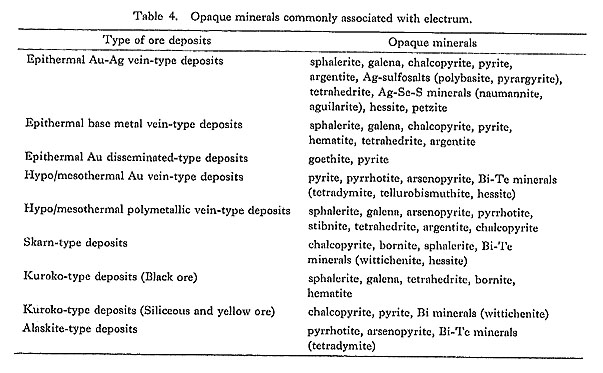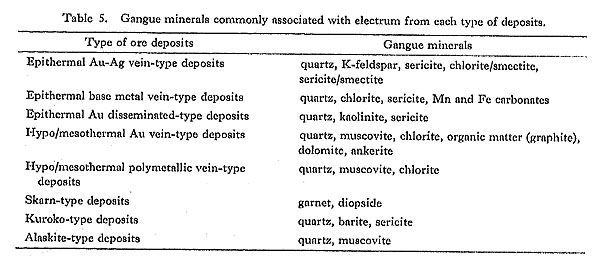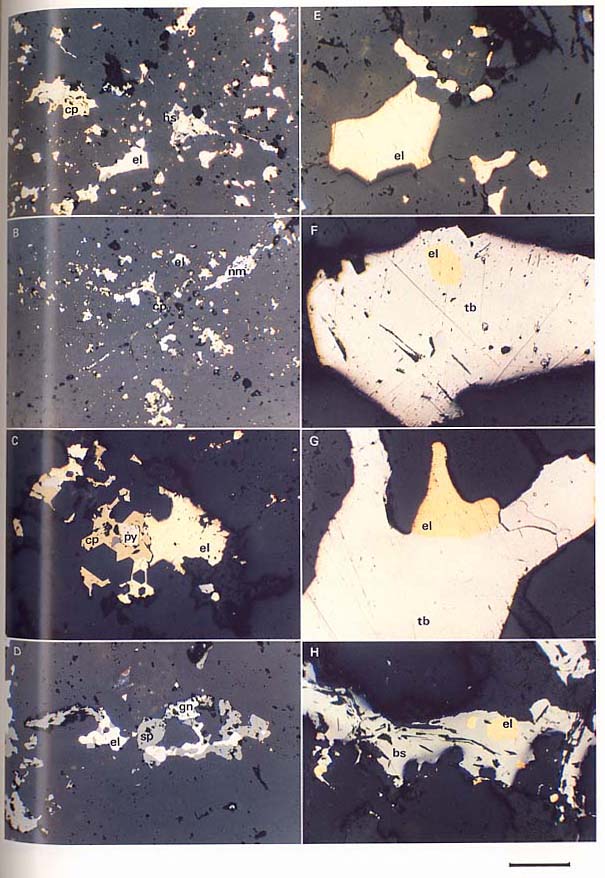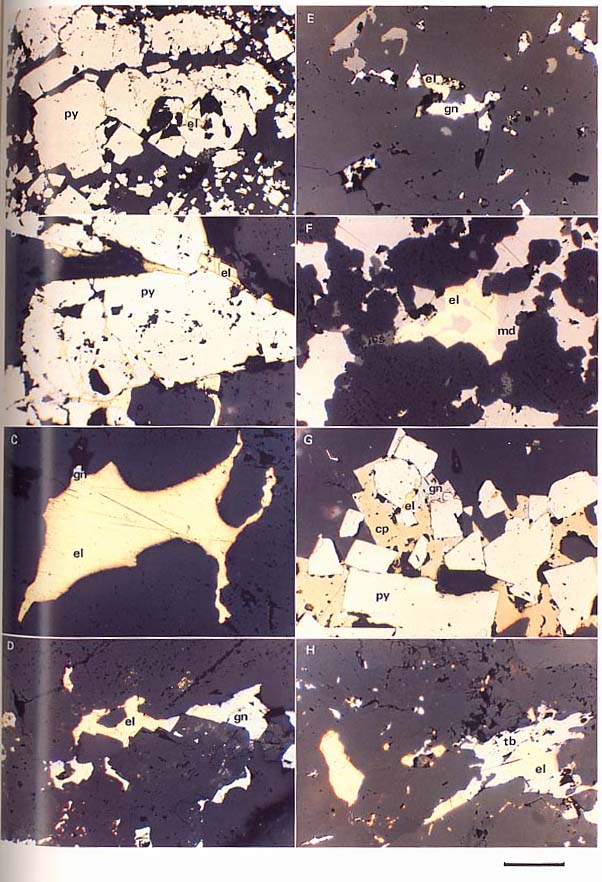CHAPTER III
Mode of Occurrence of Electrum and Associated Minerals
|
Based on the observations of many hand specimens, polished sections and thin sections from the deposits studied, and the literature, the mode of occurrence of electrum is summarized below. Main opaque and gangue minerals intimately associated with electrum from each type of deposits arc summarized in Tables 4 and 5.
1. Epithermal-Type Deposits(1) The main minerals in contact with electrum from epithermal Au-Ag vein-type deposits are fine-grained quartz, chalcedonic quartz, and sulfide minerals (galena, argentite, chalcopyrite, sphalerite, pyrite), Ag sulfosalts (polybasite, pyrargyrite, pearceitc), and tetrahedrite-tennantite minerals, Ag selenides (naumannite, aguilarite), and Au-Ag tellu-rides (hessite, petzite). In the ginguro bands, electrum is surrounded generally by sulfide minerals. The common sulfide minerals in direct contact with electrum are argentite (Plate 1-E), acanthite, galena, chalcopyrite (Plate 1-F), and Ag-sulfosalts (Plate 1-G). Direct contact of clectrum with sphalerite (Plate 1-H) is less common.
(2) In the deposits associated with Te and Se mineralizations, very fine-grained electrum is dispersed in quartz with Au-Ag tellurides or selenides or both. Occasionally, electrum is in mutual contact with Au-Ag tellurides (Plate 2-A) and selenides (Plate 2-B). Au-Ag tellurides and selenides are markedly antipathic in occurrence.
(3) Electrum is sometimes scattered in pyrite as fine grains (Plate 2-C), For instance, pyrite from the Chitose deposit contains high gold content (22 to 0.1 ppm) probably because of the existence of fine-grained electrum (Takatori and Nohno, 1985). (4) It is noteworthy that K-feldspar (adularia) and carbonates (calcite, Mn carbonates) are ubiquitous in epithermal Au-Ag vein-type deposits. But, they are not in mutual contact with electrum except for some deposits (e.g., Kushikino), and in general the stage of precipitation of these minerals is different from that of electrum. The most common gangue mineral in direct contact with electrum is quartz. (5) The Au content of clay-rich ore is sometimes high. This suggests that clay minerals (e.g., interstratified chlorite/smectite and sericite/smectite mixed-layer minerals) are commonly associated with electrum. For instance, it was reported that electrum coexists with chlorite in the Fuke deposit (Muto, 1952). (6) In the epithermal base metal-rich vein-type deposits, Au is rich in "Narumi" ore which is characterized by chlorite-quartz-hematite assemblage (Hori, 1940; Shiikawa, 1952). (7) The most common minerals in direct contact with electrum in epithermal base metal vein-type deposits are galena, tetrahedrite-tennantite minerals, chalcopyrite, sphalerite and argentite instead of quartz (Plate 2-D) (e.g., the Oe deposit) (Urashima et al., 1967). (8) In the disseminated-type deposits, electrum is enriched in the goethite-rich parts, and is dispersed in silicified rock. This fine-grained electrum is thought to be contained also in pyrite. (9) Very fine-grained electrum is contained in limonite vein in the epithermal vein-type deposits in Taiwan. Electrum is sometimes associated with enargite and luzonite (Sakazaki et al., 1963, 1964a, b; Otagaki, 1970). 2. Hypo/Mesothermal Vein-Type Deposits(1) Electrum is occasionally observed in quartz in hypo/mcsothermal Au vein-type deposits (Plate 2-E). (2) Electrum from hypo/mesothermal Au vein-type deposits (e.g., Gohaku), which occurs in the sedimentary rocks, is frequently included in the organic matter-bearing part in the vein, which is derived from the wall rocks (black shale). (3) Electrum from Japanese hypo/mesothermal Au vein-type deposits is frequently included in the grains of Bi and Te minerals such as tellurobismuthite (Plates 2-F and 2-G), tetradymite, and bismuthinite (Plate 2-H) (e.g., the Oya, Kohoku, Ashiyasu, and Kinkei deposits) (Abe, 1981; Yamaoka, 1981; Nedachi, 1974). This type of association has not been reported from hypo/mesothermal vein-type deposits in the Korean Peninsula. (4) Electrum from hypo/mesothermal Au vein-type deposits in the Korean Peninsula is included in arsenopyrite and pyrite (Plate 3-A) (Kaneda et al., 1986). The association of arsenopyrite and electrum is uncommon in hypo/mesothermal Au vein-type deposits in Japan (Plate 3-B).
(5) Galena is sometimes intimately associated with electrum in hypo/mesothermal Au vein-type deposits in Japan (e.g., the Saigane and Amo deposits; Plates 3-C and 3-D). (6) Pyrrhotite, which is a common mineral in hypo/mesothermal Au vein-type deposits, is not in direct contact with electrum. (7) Electrum from hypo/mesothermal polymetallic vein-type deposits coexists with sul-fide minerals such as argentite, chalcopyrite, sphalerite, galena, and matildite (Plates 3-E and 3-F). 3. Kuroko-Type DepositsThe Au content of black ore is generally high, but that of yellow ore and siliceoua orchis low. In the black ore, electrum is intimately associated with bornite, tetrahedrite-tennantite minerals, galena, sphalerite, and polybasite-pearceite minerals. Argentite is very rare in the black ore zone. In the yellow and siliceous ores, electrum occurs in chalcopyrite and pyrite grains (e.g., the Ainai-Daikoku, Yoahino, and Nurukawa deposits; Matsukuma, 1985; Irnai et al., 1981; Plate 3-G). In the yellow ore, fine-grained electrum is associated with Bi minerals (wittichenite and emplectite; the Yokota and Tashiro deposits; Matsukuma, 1985). 4. Bedded Cupriferous Iron Sulfide-Type DepositsA detailed study on, the mode of occurrence has been carried out only on the Shimokawa deposit (Maeda et al., 1981). Electrum occurs in compact massive or banded ores in the upper horizon. This mineral is intimately associated with sphalerite and pyrrhotite. 5. Skarn-Type DepositsElectrum coexists with bornite, chalcopyrite, wittichenite, garnet, and quartz in the Tsumo-Maruyama deposit (Sugaki et al., 1981). The minerals coexisting with electrum occurring in the Kamaishi-Nippo (Omine) deposit are chalcopyrite, diopside, garnet, born-ite, and pyrrhotite. Electrum analyzed occurs in marble. Miyazawa (1953) indicated that electrum is included in sphalerite and is associated with pyrrhotite in the Chichibu-Daikoku deposit. In the Holgol deposit, electrum is intimately associated with bornite and chalcopyrite (Watanabe, 1933). 6. Alaskite-Type DepositsElectrum occurs generally in quartz, arsenopyrite, pyrite, and pyrrhotite. Electrum is in direct contact with tetradymite at the Geumjeong deposit (Plate 3-H). |




